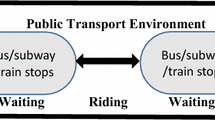Abstract
This study focuses on bystander perceptions and expected responses to unwanted sexual behaviours on public transport. Level of blame, incident seriousness, likelihood of reporting and intervening were evaluated using a series of 6 vignettes that manipulated passenger density and severity of the behaviour. Half of the participants also viewed a video to raise their awareness of unwanted sexual behaviours. The results indicated that blame was attributed to the perpetrator and not the victim, with perpetrator blame, incident seriousness and likelihood of reporting all being influenced by a passenger density and behaviour severity interaction. Increasing awareness of unwanted sexual behaviours had no effect with the exception of likelihood of intervention. Findings are discussed in relation to women’s safety during travel in peak and off peak hours as well as the role of the bystander. Finally, the article concludes with considerations of these findings for women’s safety in transit settings.
Similar content being viewed by others
References
Bates, L. 2014. Everyday sexism. London: Simon & Schuster UK Ltd.
Batson, C.D. 1998. Altruism and prosocial behaviour. In The handbook of social psychology, ed. D.T. Gilbert, S.T. Fiske, and G. Lindzey. Boston, MA: McGraw- Hill.
BTP—British Transport Police. 2015. Report it to stop it: Tackling unwanted sexual behaviour on public transport. [online]. http://www.btp.police.uk/advice_and_information/how_we_tackle_crime/report_it_to_stop_it.aspx. Accessed 25 Apr 2017.
Burgess, A.W., and L.L. Holstrom. 1985. Rape trauma syndrome and post-traumatic stress response. In Rape and sexual assault, ed. A.W. Burgess. New York: Garland Publishing.
Burt, M. 1980. Cultural myths and supports for rape. Journal of Personality and Social Psychology 38 (2): 217–230.
Ceccato, V. 2014. Safety on the move: Crime and perceived safety in transit environments. Security Journal 27 (2): 127–131.
De Judicibus, M., and M.P. McCabe. 2001. Blaming the target of sexual harassment: Impact of gender role, sexist attitudes, and work role. Sex Roles 44 (7): 401–417.
Eagly, A.H., and M. Crowley. 1986. Gender and helping behavior: A meta-analytic review of the social psychological literature. Psychological Bulletin 100 (3): 283–308.
Ekore, J.O. 2012. Gender differences in perception of sexual harassment among university students. Gender and Behaviour 10 (1): 4538–4569.
Ferraro, K.F. 1995. Fear of crime: Interpreting victimization risk. New York: State University of New York Press.
Gekoski, A., J.M. Gray, M.A.H. Horvath, S. Edwards, A. Emirali, and J.R. Adler. 2015. What Works. In Harassment and sexual offences on public transport nationally and internationally: A rapid evidence assessment, ed. Reducing Sexual. London: British Transport Police and Department for Transport.
Herrera, M.C., A. Herrera, and F. Exposito. 2014. Stop harrassment! Men’s reaction to victims’ confrontation. The European Journal of Psychology Applied to Legal Context 6 (2): 45–52.
Hughes, H., and M. Huby. 2004. The construction and interpretation of vignettes in social research. Social Work & Social Sciences Review 11 (1): 36–51.
Keddy, K. 2015. Safety is just a thing men take for granted: Teaching a spatial vocabulary of equality to architecture students. Atlantis: Critical Studies in Gender, Culture & Social Justice 37 (1): 39–53.
Lambillion, A. 2012. Serious sexual offences problem profile. London: British Transport Police.
Landström, S., L.A. Strömwall, and H. Alfredsson. 2016. Blame attributions in sexual crime: Effects of belief in a just world and victim behavior. Nordic Psychology 68 (1): 2–11.
Latané, B., and J.M. Darley. 1970. The unresponsive bystander: Why doesn’t he help? Englewood Cliffs, NJ: Prentice Hall.
Lo, C. 2013. Project Guardian: Standing up to Sexual Harassment [online]. http://www.railway-technology.com/features/feature-project-guardian-sexual-harassment-public-transport/. Accessed 25 Apr 2017.
London Assembly. 2016. Crime on public transport. London: Great London Authority.
Loukaitou-Sideris, A. 2014. Fear and safety in transit environments from the women’s perspective. Security Journal 27 (2): 242–256.
Loukaitou-Sideris, A. 2016. A gendered view of mobility and transport: Next steps and future directions. Town Planning Review 86 (5): 547–565.
Loukaitou-Sideris, A., A. Bornstein, C. Fink, L. Samuels, and S. Gerami. 2009. How to ease women’s fear of transportation environments: Case studies and best practices. CA: Mineta Transportation Institute.
Madan, M., and M. Nalla. 2016. Sexual harassment in public spaces: Examining gender differences in perceived seriousness and victimization. International Criminal Justice Review 26 (2): 80–97.
Newton, A.D. 2014. Crime on public transport. Encyclopedia of criminology and criminal justice, 709–720. London: Springer.
Nickerson, A.B., A.M. Aloe, J.A. Livingston, and T.H. Feeley. 2014. Measurement of the bystander intervention model for bullying and sexual harassment. Journal of Adolescence 37 (4): 391–400.
Pina, A., T.A. Gannon, and B. Saunders. 2009. An overview of the literature on sexual harassment: Perpetrator, theory, and treatment issues. Aggression and Violent Behavior 14 (2): 126–138.
Stringer, S.M. 2007. Hidden in plain sight: Sexual harassment and assault in the New York City transport system. New York: Manhattan Borough President Office.
Suarez, E., and T.M. Gadalla. 2010. Stop blaming the victim: A meta-analysis on rape myths. Journal of Interpersonal Violence 25 (11): 2010–2035.
TfL—Transport for London. 2015. Safety and Security Annual Report 2014. [online]. http://content.tfl.gov.uk/safety-and-security-annual-report-2014-15.pdf. Accessed 25 Apr 2017.
TfL—Transport for London (2016) ‘Report it to stop it’ increases public confidence to report unwanted sexual behaviour. [online]. https://tfl.gov.uk/info-for/media/press-releases/2016/february/-report-it-to-stop-it-increases-public-confidence-to-report-unwanted-sexual-behaviour. Accessed 25 Apr 2017.
Twyford, R. 2013. Report: Project guardian-public awareness campaign rationale. London: Project Guardian.
Yavuz, N., and E.W. Welch. 2010. Addressing fear of crime in public space: Gender differences in reaction to safety measures in train transit. Urban Studies 47 (12): 2491–2515.
Yu, S.V., and M.J. Smith. 2014. Commuters using public transit in New York City: Using area level data to identify neighbourhoods with vulnerable riders. Security Journal 27 (2): 194–209.
Author information
Authors and Affiliations
Corresponding author
Rights and permissions
About this article
Cite this article
Ball, K.S., Wesson, C.J. Perceptions of unwanted sexual behaviour on public transport: exploring transport density and behaviour severity. Crime Prev Community Saf 19, 199–210 (2017). https://doi.org/10.1057/s41300-017-0026-3
Published:
Issue Date:
DOI: https://doi.org/10.1057/s41300-017-0026-3




